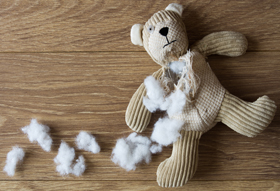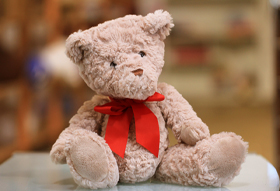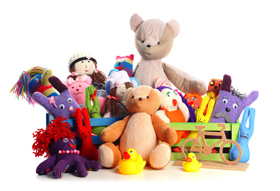
Revitalising old toys

To some, the thought of having to part with a long-cherished toy is unfathomable. Whether a toy is a cherished gift or precious family heirloom, even with the utmost of care, stuffed toys can soon become in need of restoration. However, professional toy restoration does not come cheap, and many wish to take repair and rejuvenation into their own hands.
One of the most common problems encountered by vintage stuffed toys is the reduction in fullness. Common stuffing materials include synthetic fibre, wood wool, cotton, straw and beans. Most modern toys on the other hand are filled with polyester toy filling, which is specifically designed to help a plush toy retain its shape and fullness. For older toys, the difference in inner materials means that the effect is not quite the same.
So, how do you best go about restoring a vintage stuffed toy?

1) Remove inner materials
The first step in rejuvenating old toys is by finding an appropriate point in which to unstitch the product. For vintage teddy bears, for example, this is usually the central seam running down the back of the toy.
For products of a different shape, it is best to find a seam that is fairly hidden. However, it is important to consider whether you can efficiently remove and insert the inner material throughout the entire toy by using that single opening.
Once you have found the appropriate seam or opening point, proceed to remove as much stuffing as possible.
2) Cleaning
Removing the inner stuffing of a plush product provides the perfect opportunity to give the toy a thorough clean – a good idea, considering a vintage toy may have accumulated years of dust and dirt.
Pre-treat any stains with a gentle stain remover and use a sponge to gently blot any marks. Then, remove any additional accessories, clothes and sound boxes from the toy before placing it in a white pillowcase. Tie the case securely – this ensures that the toy remains safely inside the pillow case to protect any features such as plastic eyes.
Be sure to wash the toy on a gentle, low-temperature cycle and add a little fabric conditioner to the rinse cycle to ensure a soft and fluffy outcome. Finally, leave the toy to try for a day or two (depending on thickness of material and size of toy), keeping it out of direct sunlight.

3) Preparing your foam stuffing
Considered one of the most versatile materials, foam can be used to re-fill stuffed toys – even those in the strangest of shapes. At eFoam, we supply foam offcuts that can be very easily broken down into tiny pieces and used in craft applications. Alternatively, if you only require a small amount of foam filling, we also manufacture reconstituted chipped foam, which can then be cut down into appropriate ‘crumb-like’ pieces.
First, begin by stuffing the most tricky-to-reach areas of the toy. With a teddy bear, for example, it is best to start with the ears, before stuffing the arms and then legs. Ensure that the foam is compacted to your desired firmness. Then, proceed to fill the main section, or the body. Be sure to not overfill this area – you’ll need enough give in the material to re-stitch the toy!
If you require any assistance, or have any questions on how best to use foam to rejuvenate an old toy or soft furnishing, do give one of our friendly advisers a call on: 0800 043 9990 or contact us.

